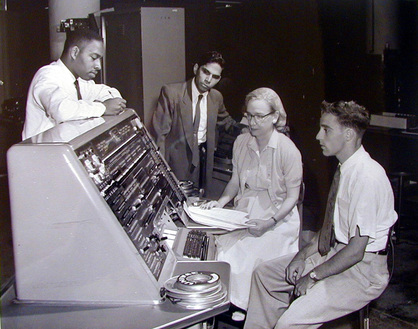due in class on
In 2009, recognizing the national need for education in computer science and other technical fields, the United States Congress instituted Computer Science Education Week, an annual event scheduled in December to coincide with the birthday of Admiral Grace Hopper, a pioneer who made substantial contributions to profession of computer programming. This year (2011), CS Education Week is December 4–10.

Grace Hopper and colleagues
For this assignment, we will form groups of 4–5 students each and work to create some kind of learning artifact with the intent of releasing it to the public at large during CS Education Week.
Your artifact may be a handout (with color illustrations, not just text descriptions), a short audio segment, or a full video demonstration (about 3–5 minutes). Our goal in creating the artifacts is to teach some computing concept to students in middle or high school — consider them to be your target audience. If you have younger siblings that you can involve in the demonstration, even better!
The computing concept you focus on can have something to do with binary encoding, logic, a particular algorithm, or any other topic. I have a list of possible topics below, as well as some inspirational examples to be found on the web.
You have until the end of October to complete the artifact. If I find your work suitable, I may help you continue to polish it throughout the month of November so that we can make a nice impact for CS Education Week in December.
Ground rules
Exchange contact information and elect a group liaison. This is the person whose primary responsibility will be to contact with me to ask and answer questions about your project.
Your artifact should include a short section that gives credit to all group members and acknowledges any resources you used from the web or your text book.
I will devote some class time throughout the month to meeting with your group and discussing plans, but you will certainly have to meet outside of class also.
By October 12th (one week in), I need to hear from your group liaison about (1) what type of artifact you are designing, (2) what topic you will cover, and (3) some preliminary design ideas and notes.
By October 19th (two weeks in), I’d like to see more concrete plans, such as a script.
Topic ideas
You can see me about any of these for more of the technical details, but it’s up to you how to demonstrate the details in a creative way in your artifact.
Demonstrate a sorting algorithm, especially a less common one such as gnome sort or heap sort.
Something with binary numbers, such as explaining two’s complement, addition and subtraction.
Encoding and decoding color images using a specified number of bits per pixel and either a color map or RGB values.
A demonstration of lossy compression, where you create a JPEG photo or MP3 song using lower and lower quality and observe the difference it makes.
An explanation of Huffman encoding to compress text, like the trees on the handout.
Organizing data in a “binary tree” to make it faster to search.
Some examples
Below are some sample videos to get you thinking about the kind of demonstrations and learning experiences I have in mind. Many are from “Computer Science Unplugged”, a project from the University of Canterbury in New Zealand, with collaborators all over the world.
Binary numbers
Some demonstrations of binary numbers for a live audience.
An explanation of “gray code”, which is an alternative formulation of binary numbers. This video nicely demonstrates that you can give a short, effective explanation just by narrating PowerPoint slides.
Image encoding
A compact way to encode images, different from the one we discussed.
Sorting
A demonstration of insertion sort (and other algorithms in other videos) using playing cards.
A clever way to compare two different sorting algorithms.
Binary trees
One wonderful video in a series by Vi Hart, a “recreational mathematician” from Long Island.
©2011 Christopher League · some rights reserved · CC by-sa